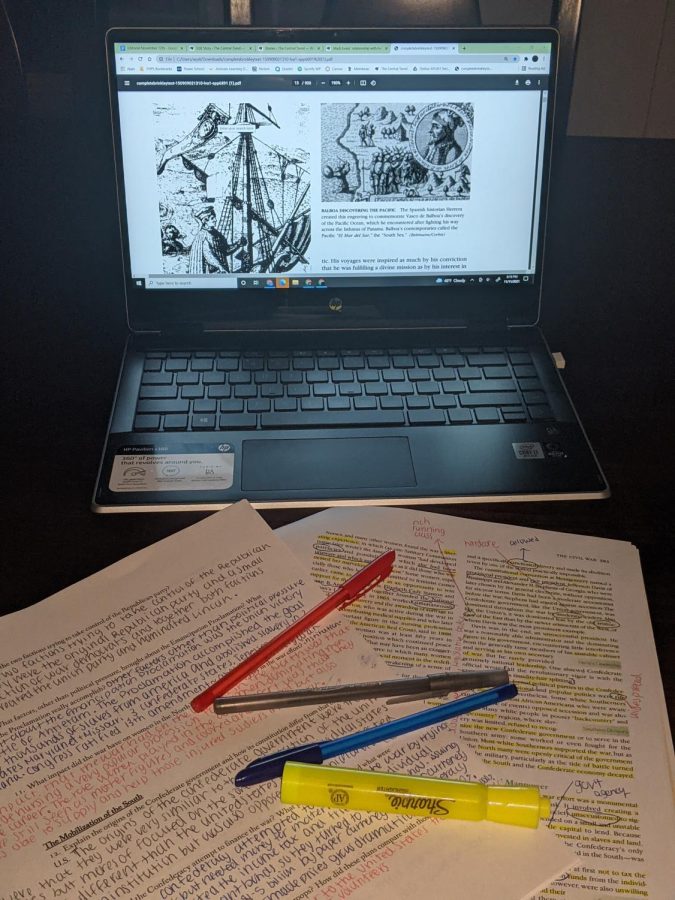What are the most effective study habits?
A picture of my notes and online textbook for my APUSH homework.
Over the course of the years, I’ve learned that spending free time wisely is crucial for students. Sleep and school consume two-thirds of a student’s life, leaving only seven hours for anything else.
Now, assuming for most, the majority of the time spent after school is either devoted towards completing homework, participating in sports, or studying for assessments. What if there was a way to reduce the amount of time we spend studying and somehow absorb the content better?
Of course, there’s the classic utilization of flashcards where you focus on remembering the definition of a term in hopes of being able to know the answer when it appears on a quiz or test. Then, there is note-taking: the approach of jotting down important information when reading from sources such as textbooks and presentations and focusing on the important parts of the lesson. Lastly, there is the technique of highlighting only the important parts of the reading.
But how effective are these methods when it comes to studying? According to the website Classcraft, when it comes to preparing for assessments, there are two ways of learning content: active learning and passive learning. Active learning is the practice of allowing the brain to recall and retain information. Examples of this include games, challenges, labs, and group problems. The benefits of active learning allow students to create a better understanding of what they are learning and improve their critical thinking skills.
Passive learning, however, is more dependent on how the student chooses to study. Examples of this include highlighting important information in readings and watching videos that summarize the unit. Although this technique is useful, some disadvantages to using it are that it can often get tedious and become difficult to comprehend information. Passive learning can also make students forget instead of remembering what they are learning.
Compared to other methods of learning, active learning has been shown to be more efficient in terms of students being able to understand and remember more information in shorter periods of time versus trying to memorize information and not actually make sense of what is being learned.
Aside from deciding which approach to utilize when studying, studies have shown that there are a multitude of factors that are critical when it comes to studying. According to the website MindTools, the “Forgetting Curve” is a common theory that states that after something is learned, it is easier to forget as the hours pass by if it’s not reviewed every day.
Luckily, there is a solution to this problem. A new method recently discovered within the past decade has been proven to increase the ability for the retention of knowledge and strengthen the connections made inside of the brain, which is a method called active recall.
Active recall is the habit of training the brain to recollect information that it processes. Compared to reviewing material and cramming information into your head, active recall allows the memory to become stronger and lets the brain function the way it’s supposed to by being able to tap into your subconscious and retrieve rather than ram the mind with a lot of facts.
Although active recall can be difficult to practice itself, the advantages gained from it are far more effective in comparison to trying to memorize concepts and not actually interpret the content. With this approach, cognitive abilities can improve, information can be stored in your long-term memory, and as once author Kevin Paul said “Study smarter, not harder.”
There are many options that are available when it comes to implementing active recall in studies. For example, when scanning a textbook for a course, it is recommended that the SQ3R method be used when studying.
The acronym SQR3 stands for survey, question, read, recite, and review. Skim the material before reading it, generate questions to later find answers to when reading the textbook, read the text, and find the answers to the questions. Then, later, try to answer the questions from memory, and when you find questions that are tough to answer, review them again.
In addition to the SQ3R method, there is another common technique to use active recall in studying. A physicist by the name of Richard Feynman invented the Feynman Technique: a method of studying used for better retention of information by being able to teach it to others and by having a peer ask questions and explain the information in the one teaching’s own words.
Along with using these techniques, it is also equally as important not only to review but also to retain the content being taught. With the implementation of spaced repetition while studying, the forgetting curve can be reduced, raising retention in the brain.
Spaced repetition allows the memorization of content to be repeated across increasing intervals. An example of this would be to say if there was an assessment Friday, review the content one hour a day Monday through Thursday compared to an extended session on Thursday the day before the assessment.
With this method of spacing out study sessions, remembering information over longer periods of time becomes easier and allows you to study for shorter periods of time every day, preventing fatigue and obliterating the material being learned.
Applying these forms of active recall into my studying has allowed me to not only learn the content better but also has reduced the length of my studying sessions and has given me a chance to devote my time to more important elements of my life, such as being able to spend time with my family and get outside to connect with nature. If everyone used this approach when preparing themselves for assessments, we all would have more of an appreciation for studying.

Arpita is a senior entering her third and final year as a staff writer on The Central Trend. She has been a part of the Science Olympiad team since the...

























































































